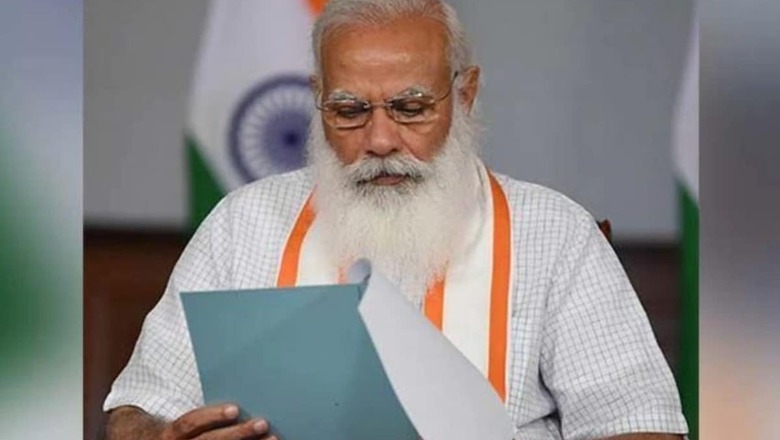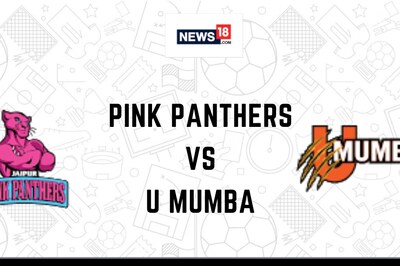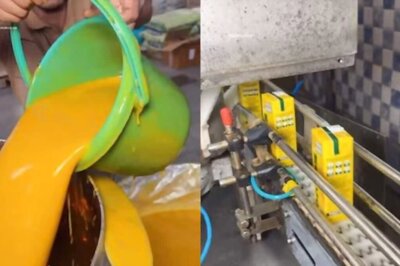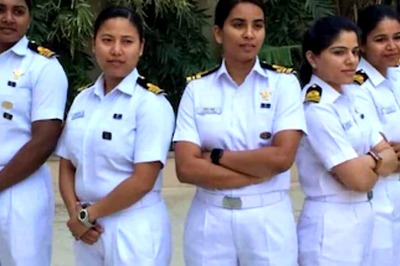
views
Before you are a leader, success is all about growing yourself. When you become a leader, success is all about growing others – Jack Welch
Prime Minister Narendra Modi, keeping in mind this adage, marched ahead with a cabinet overhaul and expansion, where talent and meritocracy ruled the roost. He gave shape to Team Modi 2.0 on Wednesday, June 7, ahead of crucial Assembly elections in seven states in 2022. Talk of a cabinet expansion and reshuffle had been in the offing for some time now.
While 57 ministers took oath in 2019, that number had fallen to 53, with the resignations of Arvind Sawant of the Shiv Sena and Harsimrat Kaur Badal of the Shiromani Akali Dal, and the demise of two others, namely Ram Vilas Paswan of the Lok Janshakti Party and Suresh Angadi of the BJP. On June 6, with Minister for Social Justice and Empowerment Thawarchand Gehlot being appointed as the Governor of Karnataka, the cabinet strength came down to 52, against the upper limit of 81.
Hence, the decision by the Prime Minister to increase the cabinet strength from 52 to 77 was both necessary and desirable. Clearly, the resignation of 12 ministers and elevation of seven others sent out a loud and clear message of ‘perform or perish’, which has always been the Modi mantra. With 27 OBC ministers, 12 from the Scheduled Castes and eight from the Scheduled Tribes community, the cabinet has given a whole new meaning to inclusivity. Gender-wise too, a total of 11 women ministers, including two with a Cabinet rank, speaks volumes about the Modi government’s commitment to women empowerment; former Congress-led dispensations have merely paid lip service to it.
Key cabinet ministers, Rajnath Singh, Nirmala Sitharaman, S. Jaishankar, Narendra Singh Tomar, retained their portfolios of Defence, Finance, External Affairs and Agriculture, respectively. Prime Minister Narendra Modi is also in-charge of Ministry of Personnel, Public Grievances and Pensions; Department of Atomic Energy; Department of Space, besides other portfolios not allocated to any minister.
From 43 leaders sworn-in as union ministers in the first Cabinet reshuffle and expansion after Prime Minister Modi returned to power for a second term in May 2019, 15 were inducted into the union cabinet and 28 as ministers of state. Among the ministers inducted into the cabinet are Jyotiraditya Scindia, Sarbananda Sonowal, Anurag Thakur, Kiren Rijiju and Hardeep Puri. Meenakshi Lekhi, Pankaj Choudhary, Anupriya Patel, Shobha Karandlaje among others were inducted as ministers of state.
ALSO READ | PM Modi’s Cabinet Rejig: A Phone Call That Led to 11 Resignations
Team Modi 2.0 has gone for several new faces with an eye on grooming younger leaders. There are 14 ministers below the age of 50, with average age of the cabinet at just about 56 years. Silos between ministries have been broken down and an efficient, wholesome approach has been the guiding force behind the new work allocation. The cabinet reshuffle also saw the induction of 13 lawyers, six doctors, seven former civil servants, seven PhDs, 68 graduates and five engineers into the council of ministers, showcasing the undeniable focus on talent.
The articulate Meenakshi Lekhi has been appointed MoS, External Affairs and Culture. Parshottam Rupala hails from Gujarat, the state with the longest coastline and where the dairy sector has been making huge strides. Rupala’s experiences in dairy and fisheries will therefore be helpful in his tenure as a cabinet minister. The civil aviation sector needed a dynamic face and Jyotiraditya Scindia will bring in new energy and new ideas to help this sector keep pace with the changing, post-COVID world. Hardeep Singh Puri, who calls a spade a spade and has had a tremendous track record both as a technocrat and as a minister, is the new Petroleum Minister, in addition to holding the Urban Development portfolio.
Dharmendra Pradhan, very hardworking and extremely meticulous, is the new Education Minister and will also handle Skill Development and Entrepreneurship Ministry to ensure greater synergies between the two ministries. Ashwini Vaishnaw, a former IAS officer with degrees from IIT Kanpur and Wharton, is the new Railways Minister, who will also to handle the Information Technology portfolio, in a clear messaging by Prime Minister Modi that he values professionals with domain expertise.
Piyush Goyal will handle the Ministry of Textiles in addition to the Ministries of Commerce and Industry. This will once again bring synergy between ministries that are export-oriented, deal with trade policy and are among the biggest employment-generating portfolios. He also handles Consumer Affairs, Food and Public Distribution.
MoS PMO will handle Science & Technology and Prime Minister Modi will actively monitor the ministry, thereby endorsing that science and innovation are high on the Modi government’s development agenda. Smriti Irani will oversee Swachh Bharat and, of course, keep the Women and Child Welfare portfolio too and will be assisted by MoS Mahendrabhai Munjapara, a noted cardiologist. There is a huge focus on the Women and Child Welfare Ministry, especially in tackling malnutrition and improving indicators like MMR and IMR.
Amit Shah, the erudite and extremely sharp Home Minister, has been given charge of the Ministry of Cooperation to further strengthen the development of multi-state cooperatives. The entire cabinet will do its best to taking the welfare policies of the government to the people and help realize the resolve of self-reliant India.
The cabinet reshuffle has been termed as an effort by Prime Minister Modi to strike a balance between regional compulsions and meritocracy, in addition to giving a greater say to marginalised communities and beefing up the talent quotient with the inclusion of professionals and highly educated individuals.
Former Assam chief minister Sarbananda Sonowal will deal with Ports and Shipping while cabinet minister from Arunachal Pradesh, Kiren Rijiju, will deal with Law and Justice. Janata Dal (United)’s RCP Singh would be the new Steel Minister, and Pashupati Paras will take charge of his brother, late Ram Vilas Paswan’s, previous portfolio.
The North-East with a Minister each from Tripura (Pratima Bhowmick) and Manipur (Rajkumar Ranjan Singh) demonstrate how for the first time in over 70 years, the Modi government is giving the North-East its due.
ALSO READ | It’s Mission UP: Narendra Modi Cabinet Expansion Sends Clear Signal before Make or Break Polls
Like all reshuffles, this one too recognized the importance of states going to polls, with Uttar Pradesh getting seven ministerial berths, taking its tally within the Council of Ministers to 14. Uttarakhand noticed the inclusion of Ajay Bhatt. Gujarat, which goes to polls later in 2022, saw Mansukh Mandaviya and Parshottam Rupala’s elevation and a minister of state berth for Darshana Jardosh, MP from Surat. Mandaviya has been given the important Health portfolio, given his excellent work during the COVID second wave, with Remdesivir production going up from 1 lakh vials to 3.5 lakh vials per day. Hence, despite electoral compulsions, meritocracy was the overriding theme.
With the inclusion of four ministers— Nisith Pramanik, John Barla, Subhash Sarkar and Shantanu Thakur, Prime Minister Modi established that West Bengal would be a vital state in the larger scheme of things for the BJP, with Thakur and Pramanik representing the Matua and Rajabangshi communities, respectively. Again, the BJP secured 25 Assembly seats in North Bengal, a region that Pramanik hails from. Although just 35 years old and a first time MP from Cooch Behar, he was included in the Council of Ministers.
The inclusion of Maratha strongman from Konkan region, Narayan Rane, nearing 70, proves that PM Modi has married experience with youth. The induction of the BJP leader and former Maharashtra chief minister, also a former Shiv Sainik, is clearly viewed by many as an aggressive move on the BJP’s part to neutralise the Sena in the Konkan. Rane ruled Kudal in Sindhudurg district—he was elected MLA from the seat six times—before being defeated by the Sena’s Vaibhav Naik in the 2014 Maharashtra Assembly election, a defeat he has not forgotten.
After a long period in limbo following his exit from the Congress, Rane was sent to the Rajya Sabha backed by the BJP. However, it was only in October 2019, just ahead of the crucial Maharashtra Assembly polls, that he finally merged his party, the Maharashtra Swabhiman Paksha (MSP), with the BJP and formally entered the BJP. Picking Rane as a minister is an excellent move by Prime Minister Modi as Rane understands the Konkan region better than most, is a career politician and is the proverbial bête noire of the Shiv Sena, which has clearly failed Maharashtra on counts more than one.
With four BJP leaders from Maharashtra starring in Prime Minister Narendra Modi’s mega cabinet reshuffle, the BJP, as per experts, appears to have worked out a well thought-out stratagem to tackle the tripartite Uddhav Thackeray-led Maha Vikas Aghadi (MVA) in key regions of the state. The exercise saw the induction of Kapil Patil from Thane district, Dr Bhagwat Karad, an important name in Marathwada, and Bharati Pawar from Khandesh as ministers of state (MoS). Thane is considered a Shiv Sena bastion and hence Patil’s induction is significant. Dr Karad, a former side of Gopinath Munde, has served as the mayor of Aurangabad Municipal Corporation and comes with years of experience, while 42-year-old Bharati Pawar, who also holds an MBBS degree, is the young face from Maharashtra.
The reshuffle also reflects a balance of caste interests: the induction of Bhagwat Karad, an influential and experienced OBC leader from the Marathwada region, is meant to give a push to the BJP’s expansion in the area, while representing vital OBC interests. The induction of Bharati Pawar, a first-time MP from Dindori, a tribal constituency in Nashik district, is being seen by some as a step to neutralise the NCP in northern Maharashtra. Kapil Patil is a two-time BJP MP from Bhiwandi; more importantly, he belongs to the farmers’ community, which reportedly has considerable clout over local politics in Thane and Navi Mumbai areas.
Before January 1, 2004, the Prime Minister had discretion to appoint any number of ministers in his Council of Ministers. But the Constitution (Ninety-first Amendment) Act in 2003 curbed this power. This Amendment added clause (1-A) in the Article 75 which limited the number of ministers, including PM, to 15 per cent of the total number of Lok Sabha members, which is 545. So Prime Minister Modi can have 81 members in the Council of Ministers. With the latest expansion, the number is still 77 and the PM still has room for more. Hence, ‘Minimum Government, Maximum Governance’ is not merely a slogan but an abiding principle for PM Modi who, besides an impeccably clean and corruption free image, works tirelessly 24×7.
ALSO READ | Big and Bold: The Narendra Modi Cabinet Reshuffle Ticks All the Right Boxes
The Prime Minister can induct in his council of ministers a person who is not a member of either of the two Houses of Parliament—the Lok Sabha and the Rajya Sabha. However, a minister who for a period of six consecutive months is not a member of either House shall at the expiration of that period cease to be one.
Former PM Atal Bihari Vajpayee’s first government in May 1996, that lasted for 13 days, had just 12 ministers (including the PM), when swearing-in took place. His second term in March 1998 began with 41 ministers, including 21 cabinet Ministers, 16 ministers of state and four ministers of state with independent charge. When he began his third term in October 1999, there were 22 cabinet ministers and 22 ministers of state. Former PM Manmohan Singh’s UPA-II started in May 2009 with 78-member council of ministers, including 33 cabinet ministers and 45 ministers of state. UPA-I too had 78 ministers in the council.
In the end, it would suffice to say that Prime Minister Narendra Modi is a rare leader and a global statesman who values talent and more importantly, nurtures talent. For him, good governance comes first, let sycophancy be damned. Modi’s KRA-style governance model with clear targets and an India First approach is a far cry from the erstwhile Congress-led dispensation which ruled the country via 78 GoMs (groups of ministers) and 16 EGoMs (empowered groups of ministers) under Manmohan Singh, with the office of the Prime Minister being compromised. But Prime Minister Narendra Modi does what he does unapologetically and has a clear thought process, with no room for obfuscation. “Don’t follow the crowd; let the crowd follow you,” said Margaret Thatcher decades back. True to his style, PM Modi’s cabinet expansion has the Modi stamp of integrity, transparency, professionalism and experience written all over it, as India gears up to march ahead in a post-Covid global order.
Read all the Latest News, Breaking News and Coronavirus News here.




















Comments
0 comment